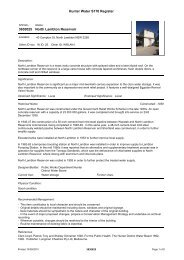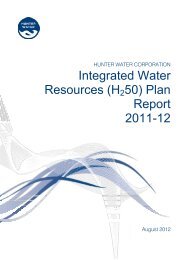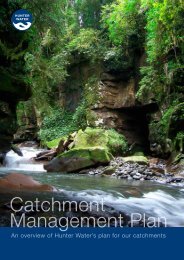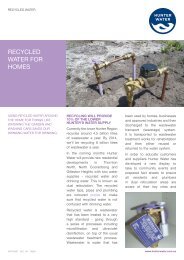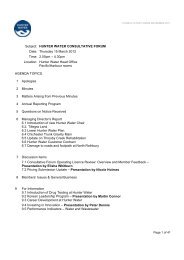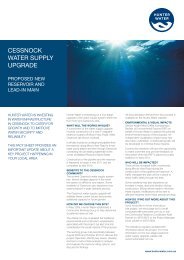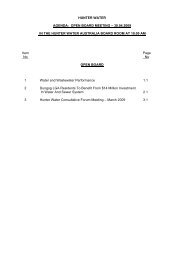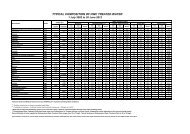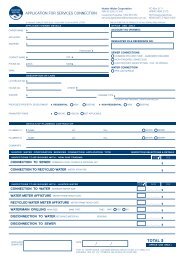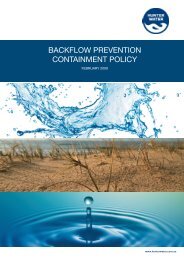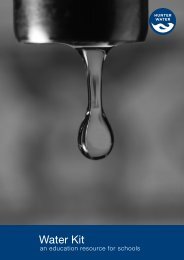Catchment Management Plan - Hunter Water
Catchment Management Plan - Hunter Water
Catchment Management Plan - Hunter Water
Create successful ePaper yourself
Turn your PDF publications into a flip-book with our unique Google optimized e-Paper software.
3.4.3 Recent improvementsto the monitoringprogramIt is becoming increasingly evident that theMedowie sub catchment presents risks todrinking water quality above others. Thereasons for this high risk rating essentiallyarise due to increasing urbanisation of thiscatchment, its proximity to GrahamstownDam and the operational requirement topump all water from this catchment intothe Dam.It is known that most toxins are mobilisedduring and after rain events . To betteralign with this risk, <strong>Hunter</strong> <strong>Water</strong> hasimplemented two event based monitoringsamplers in this catchment (provided).The samplers are simultaneously triggeredby a rising water level following rain inthe canal. They extract samples at apredetermined volume and frequencywhich are later analysed for nutrients,pathogens, turbidity and other chemicals.During the previous year, we have initiatedthe following targeted sampling programs:1. Broad suite pathogen andnutrient sampling: preliminary resultsfrom sampling indicate Campvale Canaltransports moderate to high pathogenloads after heavy rain. The numbers offaecal indicator bacteria are typical of amixed urban/rural source and representa very high risk to drinking water quality.To better determine the source of thebacteria faecal sterol analysis has beencommissioned.2. Faecal sterol analysis:Newcastle University is spearheadingthe development and use of faecalsterol analysis techniques. Faecalsterols occur in all faeces, and eachanimal (including humans) has a unique‘fingerprint’ of sterols. By analysing thesterol signature in water, we can inferfrom where the bacteria originate. Thismonitoring program will significantlyinform the management plan for thecatchment. We have currently achieveda dry weather baseline for sterols andnow require analysis of rainfall events.3. Reinstatement of phosphorouspumping rules from theWilliams River: Increasing the amountphosphorous in a river or reservoir(eutrophication) has been shown toproportionally increase the biomassof algae . We have recently fixed thereal time phosphorus analyser on theWilliams River and reinstated rules thataim to limit the phosphorus pumpedfrom the Williams River therebyreducing the risk of an algal bloom inGrahamstown Dam.3.4.4 Recommended futureactions to improve themonitoring programA peer reviewed Source <strong>Water</strong>Monitoring <strong>Plan</strong> is complete thatoptimises data collection and alignsmonitoring with high risk areas.The Source <strong>Water</strong> Monitoring Programis fully implemented with the appropriatemix of regular and event sampling, datais easily stored and retrieved using GISbased technology.<strong>Catchment</strong> data collection is routinelyreviewed to analyse highest risks and datastorage is spatially reverenced and easilyextracted by all stakeholders.HORIZON 1 HORIZON 2 HORIZON 3►This price path 2010 - 2013 Next price path 2013 - 2017 Our vision for the future 2017 - beyond►►“Part 4: The action plan 2010-2013” explains in more detail how <strong>Hunter</strong> <strong>Water</strong> will move towards this vision.CATCHMENT MANAGEMENT PLAN . ssS . 001 . JUNE201035




